Michael McFadyen's Scuba Diving - Million $ Point
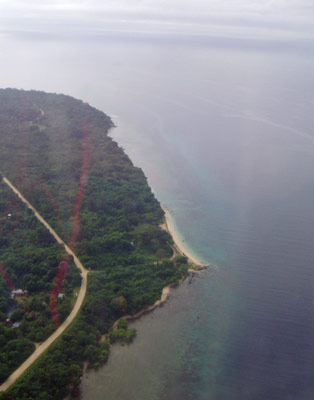 |
Million Dollar Point from the air
It is the point at the bottom of the beach |
During my first dive trip to Espirito Santo in Vanuatu, I had opted not to dive Million Dollar Point as I had been told by some people that it was not really worth the loss of a dive on the SS President Coolidge. However, during my 1995 and 1998 trips to Santo I decided that I really did want to see the amazing junk pile that in some ways showed why the Allies won the Second World War. I also dived here again in June 2007.
Million Dollar Point is located on Segond Channel less than a kilometre to the east of the Coolidge. At the end of the war, the Americans had insufficient space on its ships returning to the US to fit all the masses of equipment that had accumulated in Vanuatu. It was considered, quite reasonably, that the space was needed to take the hundreds of thousands of troops home rather than the equipment.
Additionally, it was also thought that if all the equipment returned to the US, it could severely affect the US economy as no-one would want to buy new trucks, bulldozers or jeeps when they could pick up a very cheap ex-Army one. It has also been reported to me that the vehicle/equipment manufacturers actually had clauses in their contracts with the US Government which forbid the return of equipment sent overseas. This was to protect their post-war market in the USA. I am not sure if this is true, but it could be correct.
Before and during the War, most of the non-native residents of Santo were French. Apparently the US offered to sell all the surplus equipment to the residents and/or the Colonial (French-English) Government (possibly to the residents via the Government) at a very low price. However, in a gamble that failed, the residents and the Government refused to pay in the expected knowledge that the Americans could only fit a small amount of the equipment onto their ships. The thought in the back of their minds was that the Americans would just up and leave and the equipment would be theirs to have free of charge. This was a bad tactic as the Americans had other ideas.
The American Army lined up all the surplus equipment on the shore with engines running. Hand throttles were slammed on and bricks placed on accelerators and the equipment rumbled into the channel, disappearing into water 35 metres deep just a few metres off the shore. From that day on, the site received its name due to the (then) value of the equipment dumped into the water.
After the war, there was some salvaging of the equipment by locals and fortune seekers. Reece Discombe, a New Zealander now resident in Port Vila salvaged 14 bulldozers and hundreds of tyres in 1948/9. He first dragged one bulldozer out, washed it in freshwater, put in new oil, batteries and electrics. It then started. He then used this dozer to pull the other ones out. The bulldozers, despite being in the water for more than three years, were apparently in pretty good condition (just shows the quality of US goods then).
These dozers were sent to Australia where they were sold to the Joint Coal Board of New South Wales, Australia. He also reports that he salvaged propellers, propeller shafts, copper and copper wire. However, the tyres which were sold to locals, suffered different fates. The ones which were on rims soon collapsed as they rusted to pieces. The ones not on rims were almost as good as new tyres once installed on new rims.
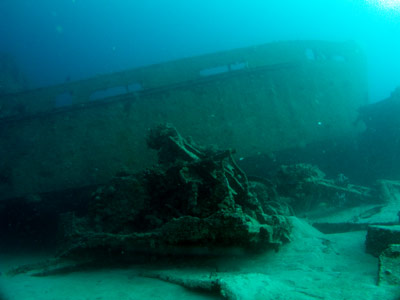 | 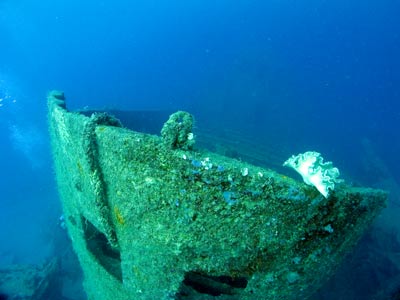 |
| The Dedele on top of a bulldozer | The bow of the Dedele |
If it was located anywhere other than a few kilometres from the SS President Coolidge, Million Dollar Point would be a major attraction in its own right, attracting divers from all over the world. As it is, the site is an excellent second dive after a deep morning dive on the Coolidge.
This is an extremely easy dive either from the shore (so long as the seas are flat - which is normal). There is a nice grassy area to gear up on and an easy walk across a narrow sandy beach to the water. As soon as you enter the water, you swim out 20 metres and decend. Head west and within a minute you start seeing masses of equipment.
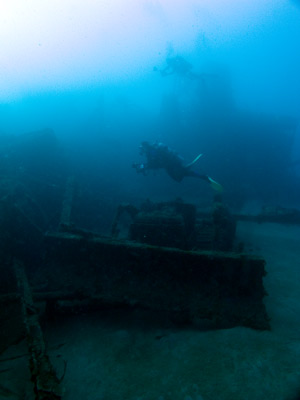 | 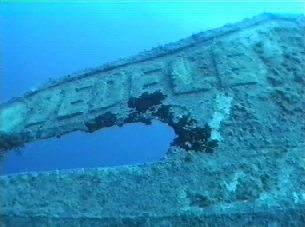 |
A bulldozer with the wreck of
the Dedele in the background | The name of the wreck, Dedele |
One of the first things you can see is the wreck of the Dedele, a small island trader that was scuttled at Million Dollar Point in the late 1970s or early 1980s. It is the first thing seen as you approach from the eastern end of the site with its bow pointing up to the sun. Five minutes gives you a good look around the whole ship. Under the wreck there are a number of tracked cranes. From the stern of the wreck, head west again.
 |  |
| The Dedele on top of a bulldozer | The bow of the Dedele |
After leaving the wreck, keep following the wreckage to the west along the sand bottom (about 35 metres) and you will be amazed by the type and quantity of equipment dumped here. As well as dozens of six wheel drive Studebaker or General Motors trucks and Willys jeeps, you will still see many bulldozers with lots of tracked excavators, graders, forklift trucks, tractors, steam-rollers, motorised scrappers, low loaders, prime movers, semi-trailers and even scaffolding. It is sometimes hard to figure out exactly what you are looking at, things are so intertwined.
After about 25 minutes of the dive the equipment peters out a bit so it is time to return to your starting point. Come up a bit into the 15 metre range for the return trip and you will see more wreckage. Steering wheels, spare tyres, Coke bottles and other items abound everywhere.
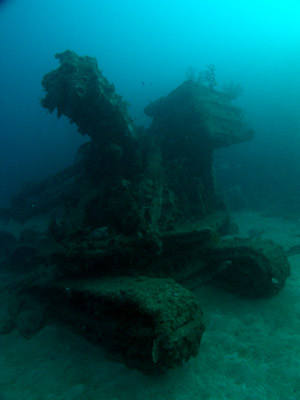 | 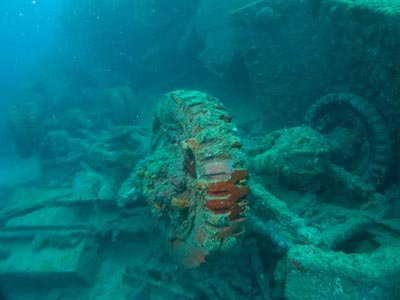 |
| A tracked crane just past the Dedele | An upsidedown truck |
Soon you see another shipwreck. This vessel is the El Retiro, a 600 ton vessel, which was being used by Donald Gubbay in a salvage attempt (both above and below the water). This ship was apparently anchored while salvaging the equipment (in the late 1940s or early 50s). When the tide went out, it is rumoured that a dozer blade went though the hull and it sank but Peter Stone in his book The Lady and the President - The Life and Loss of the S.S. President Coolidge, says that Reece Discombe (mentioned above - he was also a famous early diver and discoverer of Laperouse's ships in the Solomon Islands) told him that the ship sank when the wind blew the ship close to shore and then the tide went out and the hull was pierced by something, but not a bulldozer blade as he had never seen one in that area. Just desserts some may say. There is very good coral growth on the wreck and excellent fishlife in this shallower area.
Further along you come across what looks like packs of sheets of corrugated iron in between trucks and dozers. Eventually you return to the bow of the Dedele.
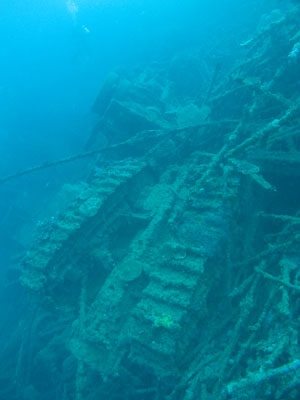 | 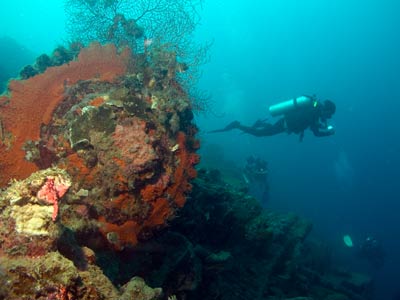 |
| An upsidedown bulldozer? | A very colourful wheel |
While there was an enormous amount of material salvaged during the late 1940s and 1950s but even so, there is still an amazing amount of equipment left to see.
Despite my earlier misgivings, this is an excellent dive and shows the extravagance of a victorious and rich nation. I would only suggest doing one day dive here (and maybe a night dive) as once you have seen one bit of wreckage, the rest is much the same. This is also good for non-divers who could easily see the main bits by snorkelling.
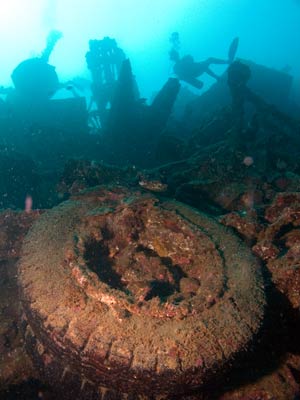 | 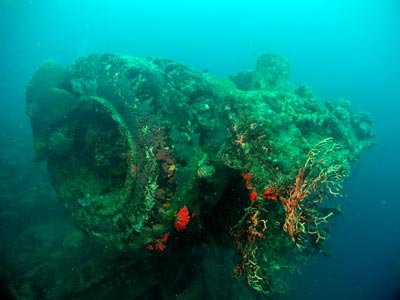 |
| Another wheel | This rear axle of truck is very prominent |
The visibility here is quite good, even better than on the Coolidge. An average of 20 metres is probably to be expected.
3D Model
Click here to see a 3D model of the site as of 2025
References:
The Lady and the President - The Life and Loss of the S.S. President Coolidge by Peter Stone.
| 
 v6.00.307 © 2003-2005
v6.00.307 © 2003-2005